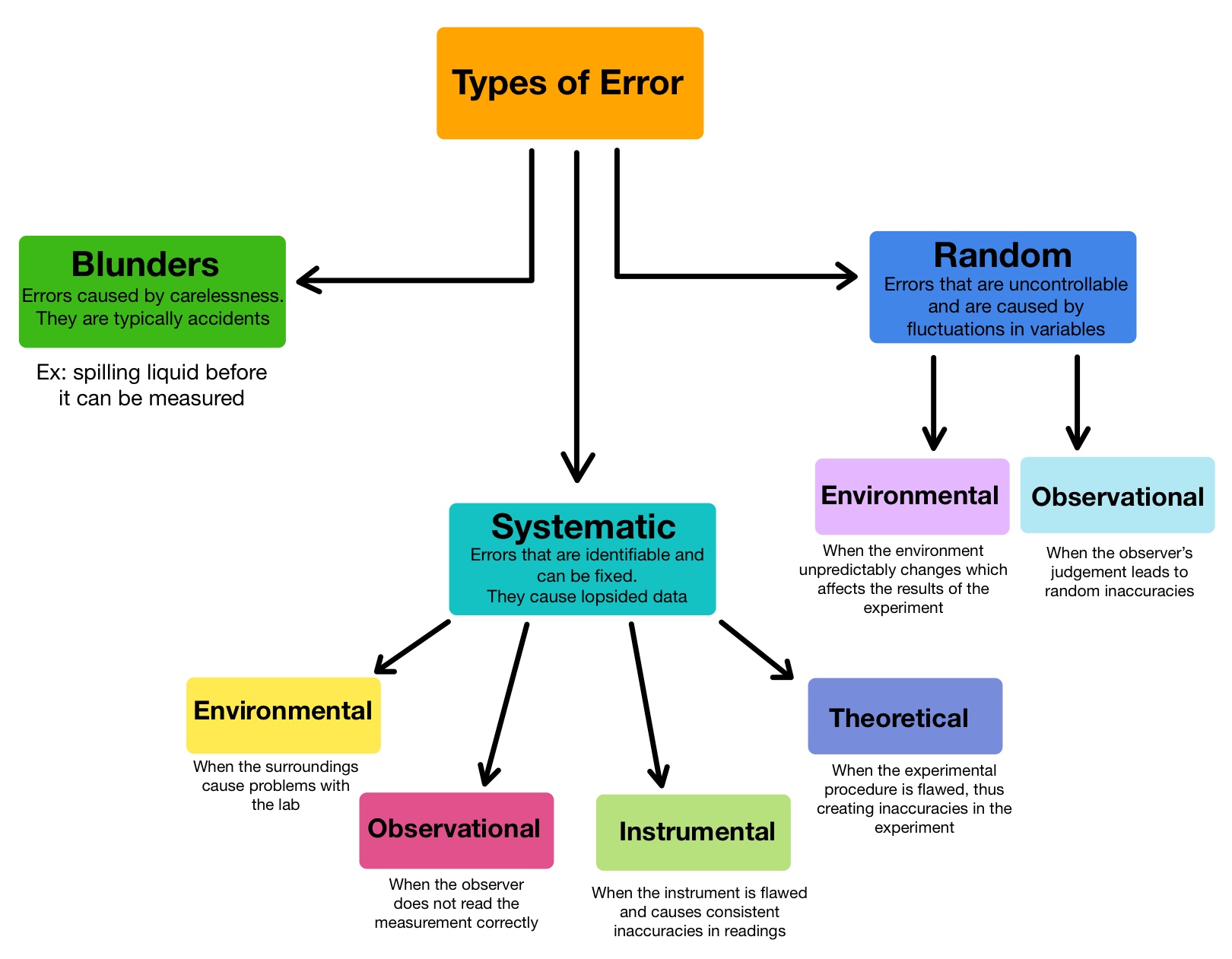What are the main types of errors?
Errors are not always due to mistakes. There are two types of errors: random and systematic.
What are the 2 main types of errors?
Errors are not always due to mistakes. There are two types of errors: random and systematic.
What are the types of errors in chemistry?
Three general types of errors occur in lab measurements: random error, systematic error, and gross errors.
What are the 2 main types of errors?
Errors are not always due to mistakes. There are two types of errors: random and systematic.
What are errors and types of errors in statistics?
Error (statistical error) describes the difference between a value obtained from a data collection process and the ‘true' value for the population. The greater the error, the less representative the data are of the population. Data can be affected by two types of error: sampling error and non-sampling error.
What is random error and systematic error?
Random error introduces variability between different measurements of the same thing, while systematic error skews your measurement away from the true value in a specific direction.
What is an error in computer?
An error in computer data is called Bug. A software bug is an error, flaw, failure or fault in a computer program or system that causes it to produce an incorrect or unexpected result, or to behave in unintended ways. … Bugs can trigger errors that may have ripple effects.
What is the zero error?
Answer: It is a type of error in which an instrument gives a reading when the true reading at that time is zero. For example needle of ammeter failing to return to zero when no current flows through it.
What are Type 1 and 3 errors?
Type I error: “rejecting the null hypothesis when it is true”. Type II error: “failing to reject the null hypothesis when it is false”. Type III error: “correctly rejecting the null hypothesis for the wrong reason”.
What are the types of errors Class 11?
There are three types of errors that are classified based on the source they arise from; They are: Gross Errors. Random Errors. Systematic Errors.
What is a method error?
Method Errors result from not being able to accurately measure the sample's concentration or mass. This usually occurs because another substance present in the sample matrix is interfering in the measurement process.
What are four major human errors?
The error of confusing cause and consequence. The error of a false causality. The error of imaginary causes. The error of free will.
What are the 2 main types of errors?
Errors are not always due to mistakes. There are two types of errors: random and systematic.
How many types of errors do we have?
Generally errors are classified into three types: systematic errors, random errors and blunders.
What are the 4 types of errors in accounting?
What are the 4 types of accounting errors? Most accounting errors can be classified as data entry errors, errors of commission, errors of omission and errors in principle.
What is called error?
An error (from the Latin error, meaning “wandering”) is an action which is inaccurate or incorrect. In some usages, an error is synonymous with a mistake.
What is the meaning of type errors?
In statistics, a Type I error means rejecting the null hypothesis when it's actually true, while a Type II error means failing to reject the null hypothesis when it's actually false. How do you reduce the risk of making a Type I error?
What is personal error?
Personal error refers to flaws introduced by the observer. For example carelessness in taking observations, and so on.
What is called systematic error?
Systematic error is an error which, in the course of a number of measurements carried out under the same conditions of a given value and quantity, either remains constant in absolute value and sign, or varies according to definite law with changing conditions.
What is the difference between constant error and systematic error?
The constant error occurs in the experiment because of the imperfection of the mechanical structure of the apparatus is known as the systematic error. The systematic errors arise because of the incorrect calibration of the device.
What is the difference between accuracy and precision?
Accuracy refers to how close a measurement is to the true or accepted value. Precision refers to how close measurements of the same item are to each other. Precision is independent of accuracy.
What is the formula for error?
Percent error formula is the absolute value of the difference of the measured value and the actual value divided by the actual value and multiplied by 100.
What is an error problem?
An error describes any issue that arises unexpectedly that cause a computer to not function properly. Computers can encounter either software errors or hardware errors.
What is error in analysis?
What is error analysis? Error analysis is a method used to document the errors that appear in learner language, determine whether those errors are systematic, and (if possible) explain what caused them.
What is end error?
End error in a meter bridge is an error brought on by the scale's zero changing at various positions as a result of the non-uniformity of the metal wire. The shifting of the scale's zero at various locations is referred to as end error.
What is least count error?
Least count error The smallest value that can be measured by the measuring instrument is called its least count. Measured values are good only up to this value. The least count error is the error associated with the resolution of the instrument.

